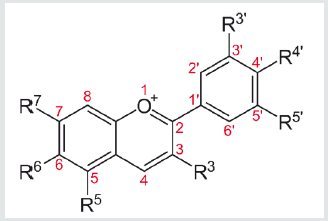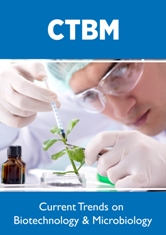
Lupine Publishers Group
Lupine Publishers
Menu
Mini Review(ISSN: 2641-6875) 
Anthocyanin: A Revolutionary Pigment for Textile industry Volume 1 - Issue 5
Priti Mathur1*, Ruby George1 and Ananya Mathur2
- 1Amity Institute of Biotechnology, India
- 2Amity Institutes of Engineering and Technology, India
Received:March 12, 2020; Published: June 17, 2020
*Corresponding author: Priti Mathur, Assistant Professor, Amity Institute of Biotechnology, Amity University Uttar Pradesh, Lucknow-226028, India
DOI: 10.32474/CTBM.2020.01.000122
Abstract
Chemical dyes from textile industry continuously degrading environment. Dyes from natural resources are proved to be ecofriendly since ancient times. Anthocyanin from plants is not only a natural dye but have many other potential characteristics. Colour of anthocyanin varies with pH which shows its adaptability to nature with varied environmental conditions Research showed that they possess antimicrobial properties. Advance research using Anthocyanin and its related gene, textile could develop with antibacterial and self-fluorescence properties. Anthocyanin is also known to protect plant in extreme weather conditions. This property could be used to develop super cloths. Anthocyanin has been used in organic solar cells because of their ability to convert light energy into electrical energy. Anthocyanin is also known to double the Shelf Life of plants. The application of genetic modification using properties of Anthocyanin in textile producing plants could bring revolution.
Keywords: Anthocyanin; Solar cells, Shelf life, Visual markers, Fluorescence, pH
Mini Review
Dyeing process in textile industry is one of the major
breakthroughs in the evolution of fashion. On the other hand, it is
well-known fact that fast fashion today degrades the environment.
The textile industry produces and uses approximately 1.3 million
tons of dyes, pigments and dye precursors, valued at around $23
billion, almost all of which is manufactured synthetically [1]. Textile
clothing ends up in landfills and chemical dyes leach into the water
bodies. Some of the chemicals found in synthetic dyes are mercury,
lead, chromium, copper, sodium chloride, toluene, and benzene.
Exposure to large doses of these substances can be toxic and can
have severe effects in the human body.
Nature has given us all necessary molecules for sustainable
development, especially in form of secondary metabolites
from plant kingdom. Natural pigments, one of the secondary
metabolites, are alternative for chemical dyes. Natural dyes are
environment friendly and have many advantages over synthetic
dyes. Natural dyes are suitable for skin and are biodegradable.
Anthocyanin is one of the pigments that can be used as a natural
dye [2]. Anthocyanin pigment can very well used as dye material
giving primarily different shades of blue purple to red. The largescale
production of textile dyed with anthocyanin is a new concept
for the textile industry.
The word ‘anthocyanin’ is derived from the Greek language.
‘Anthos’ translates into flower and ‘kianos’ means blue.
Anthocyanins belong to a group flavonoid synthesized via
phenylpropanoid pathway. They are the largest group of watersoluble
natural pigments. They are present in flower, fruit, stem,
leaves and root of plants. They soluble in water and generally occur
in the aqueous cell sap. They are found in fruits and vegetables
such as red cabbage, strawberries, grape skin, blueberries and
raspberries [3]. Anthocyanin extract of Hibiscus rosa-sinensis
flowers yield shades with good fastness properties [4]. Anthocyanin
is soluble in aqueous solutions. It becomes brighter in lower pH
range and becomes blue at higher pH levels. Colour of anthocyanin
varies with pH which shows its adaptability to nature with varied
environmental conditions [5].
Research shows that Anthocyanin has many significant properties along with its coloring nature. Some are discussed as follows (Figure 1).
A. Antimicrobial properties: Anthocyanin has been proved effective against bacteria and fungi [6]. Antibacterial fabric / infectious disease resistant fabric could be developed using anthocyanin. The application can also be used in medical linen and military uniforms. Antimicrobial clothing can prevent the growth and spread of microorganisms within the fabric and surrounding.
B. Anthocyanin as visual markers: Anthocyanins fluorescence, enabling a tool for plant cell research to allow live cell imaging without a requirement for other fluorochromes [7]. Its ability gives off fluoresce could be used for developing new advance self-fluorescence textile. Anthocyanin production may be engineered into genetically-modified materials to new generation cloths.
C. Anthocyanins double the shelf life: There are certain fabrics that do not last for a long time, although of high quality and great demand. Anthocyanins can play a role here. Life of fabrics can be increased by adding anthocyanins. Anthocyanins double the Shelf Life of tomatoes by delaying over ripening and reducing susceptibility to grey Mold [8]. This property can be genetically engineered into fabrics and used to improve shelf life of materials such as silk or chiffon.
D. Anthocyanin for extreme weather conditions: Research done for photo electrochemical cell utilizing an Anthocyanin Dye- Sensitized TiO2 Nano crystalline Electrode [9]. With advanced research, fabric could be developed with dye anthocyanin and some nanoparticle and could be proved as excellent absorber of solar energy. This property can be utilized for development of fabric for cold regions. Jackets can be manufactured which absorb the sun rays and transform them into heat. Anthocyanin has also shown a protective role in plants against extreme temperatures [10]. Tomato plants protect against cold stress with anthocyanin countering reactive oxygen species, leading to a lower rate of cell death in leaves. With advance research, properties shown by anthocyanin can be used for protective fabric for prevention from heat [10] also.
E. Anthocyanins: dye-sensitized solar cells: Anthocyanins have been used in organic solar cells because of their ability to convert light energy into electrical energy. Benefits using dye-sensitized solar cells instead of traditional p-n junction silicon cells include lower purity requirements and abundance of component materials, as well as the fact that they may be produced on flexible substrates, making them amenable to rollto- roll printing processes [11]. This property of anthocyanin could be used in textile industries to make super cloths.
Conclusion
Research has proven that anthocyanin holds great potential for fabric industries not only as dye but for development of “super cloths”. The world is now moving towards ‘Eco-fashion’. The use of natural dyes such as anthocyanin may bring revolution in textile industries. The application of genetic modification can bring about many other benefits such as visual markers and solar dyes which will increase the output of the fabric industry thus reducing the total cost. The washing fastness is also considerably good in anthocyanin dyed fabric. This pigment has good scope in the commercial dyeing of cotton, silk and wool for garment industry.
References
- Dharumadurai D, Jiang y (2016) Actinobacteria basic and biotechnological application. Intech, p. 21.
- Khoo HE, Azlan A, Tang ST, Lim SM(2017)Anthocyanidins and anthocyanins: colored pigments as food, pharmaceutical ingredients, and the potential health benefits. Food Nutr Res61(1):1361779.
- Wang H, Hussain M, Zhou W(2017)A novel method for natural dyeing of cotton fabrics with anthocyanin pigments from Morus rubra fruits. Text Res J87(15):1896-1911.
- Ramprasath R, KaviGG, RathiTS(2017)Isolation of natural dyes from hibiscus rosasinensis and marigold flower and dyeing properties of the dyes on cotton cloth. IOSR J Appl Chem10(5): 74-79.
- Wahyuningsih S, Wulandari L, Wartono MW, Munawaroh H, Ramelan AH (2017) The effect of pH and color stability of anthocyanin on food colorant. IOP Conf Ser Mater Sci Eng193(1).
- Cisowska A, Wojnicz D, Hendrich AB(2011)Anthocyanins as antimicrobial agents of natural plant origin. Nat Prod Commun6(1):149-156.
- Kortstee AJ, Khan SA, Helderman C(2011) Anthocyanin production as a potential visual selection marker during plant transformation. Transgenic Res20(6):1253-1264.
- Zhang Y, Butelli E, De Stefano R(2013)Anthocyanins double the shelf life of tomatoes by delaying overripening and reducing susceptibility to gray mold. Curr Biol23(12):1094-1100.
- Buraidah MH, Teo LP, Yusuf SNF (2011) TiO2 /Chitosan- NH4I(+I2)-BMII-based dye-sensitized solar cells with anthocyanin dyes extracted from black rice and red cabbage. Int J Photoenergy 2011: 1-11.
- GouldKS (2004) Nature’s swiss army knife: the diverse protective roles of anthocyanins in leaves. J Biomed Biotechnol 2004(5):314-320.
- Cramer H, Choi D, Griep M, Karna SP (2011)Anthocyanin dyes in titaniumdioxide nanoparticle-dye sensitized solar cells. Proc IEEE Conf Nanotechnol(c):684-686.

Top Editors
-

Mark E Smith
Bio chemistry
University of Texas Medical Branch, USA -

Lawrence A Presley
Department of Criminal Justice
Liberty University, USA -

Thomas W Miller
Department of Psychiatry
University of Kentucky, USA -

Gjumrakch Aliev
Department of Medicine
Gally International Biomedical Research & Consulting LLC, USA -

Christopher Bryant
Department of Urbanisation and Agricultural
Montreal university, USA -

Robert William Frare
Oral & Maxillofacial Pathology
New York University, USA -

Rudolph Modesto Navari
Gastroenterology and Hepatology
University of Alabama, UK -

Andrew Hague
Department of Medicine
Universities of Bradford, UK -

George Gregory Buttigieg
Maltese College of Obstetrics and Gynaecology, Europe -

Chen-Hsiung Yeh
Oncology
Circulogene Theranostics, England -
.png)
Emilio Bucio-Carrillo
Radiation Chemistry
National University of Mexico, USA -
.jpg)
Casey J Grenier
Analytical Chemistry
Wentworth Institute of Technology, USA -
Hany Atalah
Minimally Invasive Surgery
Mercer University school of Medicine, USA -

Abu-Hussein Muhamad
Pediatric Dentistry
University of Athens , Greece

The annual scholar awards from Lupine Publishers honor a selected number Read More...






